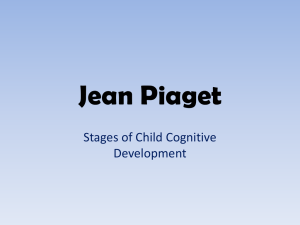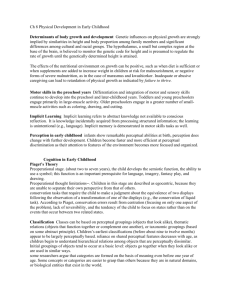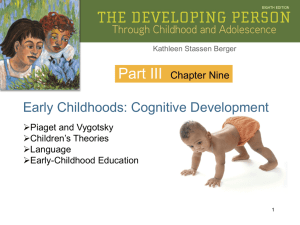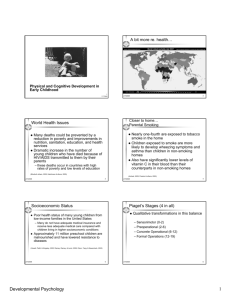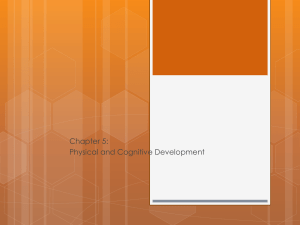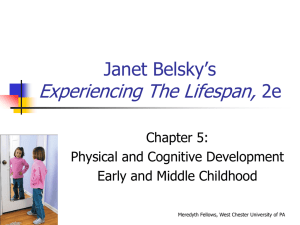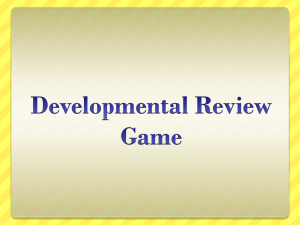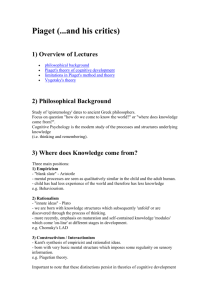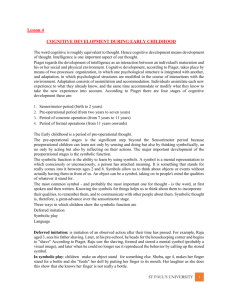Chapter 10 Outline
advertisement
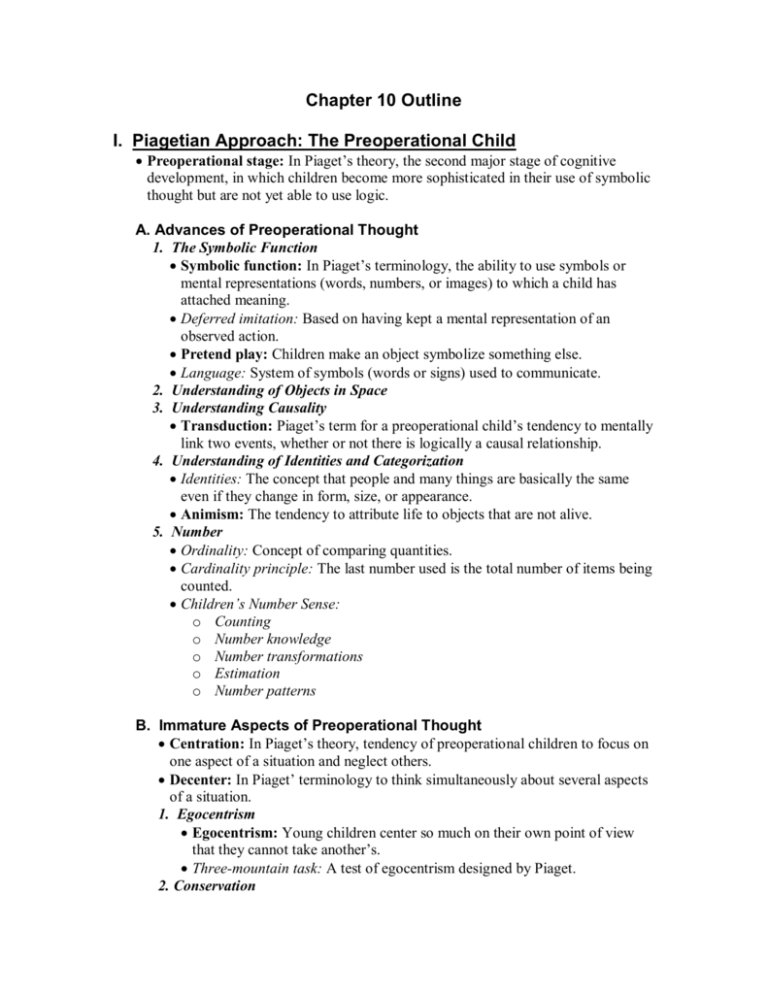
Chapter 10 Outline I. Piagetian Approach: The Preoperational Child Preoperational stage: In Piaget’s theory, the second major stage of cognitive development, in which children become more sophisticated in their use of symbolic thought but are not yet able to use logic. A. Advances of Preoperational Thought 1. The Symbolic Function Symbolic function: In Piaget’s terminology, the ability to use symbols or mental representations (words, numbers, or images) to which a child has attached meaning. Deferred imitation: Based on having kept a mental representation of an observed action. Pretend play: Children make an object symbolize something else. Language: System of symbols (words or signs) used to communicate. 2. Understanding of Objects in Space 3. Understanding Causality Transduction: Piaget’s term for a preoperational child’s tendency to mentally link two events, whether or not there is logically a causal relationship. 4. Understanding of Identities and Categorization Identities: The concept that people and many things are basically the same even if they change in form, size, or appearance. Animism: The tendency to attribute life to objects that are not alive. 5. Number Ordinality: Concept of comparing quantities. Cardinality principle: The last number used is the total number of items being counted. Children’s Number Sense: o Counting o Number knowledge o Number transformations o Estimation o Number patterns B. Immature Aspects of Preoperational Thought Centration: In Piaget’s theory, tendency of preoperational children to focus on one aspect of a situation and neglect others. Decenter: In Piaget’ terminology to think simultaneously about several aspects of a situation. 1. Egocentrism Egocentrism: Young children center so much on their own point of view that they cannot take another’s. Three-mountain task: A test of egocentrism designed by Piaget. 2. Conservation Conservation: Piaget’s term for awareness that two objects that are equal according to a certain measure remain equal even if their appearance is altered so long as nothing has been added to or taken away from either object. Irreversibility: Piaget’s term for a preoperational child’s failure to understand that an operation can go in two or more directions. Focus on successive states: By doing this, children do not see the transformation from one state to another. C. Do Young Children Have Theories of Mind? Theory of mind: Awareness of their own mental processes and those of other people. 1. Knowledge About Thinking and Mental States Social Cognition: Ability to understand that others have mental states and to judge their feelings and intentions. 2. False Beliefs and Deception 3. Distinguishing between Appearance and Reality 4. Distinguishing between Fantasy and Reality 5. Influences on Individual Differences in Theory-of-Mind Development II. Information-Processing Approach: Memory Development A. Basic Processes and Capacities Encoding: Attaches code or label to information so it can be found when needed. Storage: Putting information away until needed. Retrieval: Searching for information and taking it out of storage. Sensory memory: Temporary holding tank for brief pieces of incoming sensory information. Working memory: A short-term and limited storehouse for information that a person is actively working on. Prefrontal cortex: Area for working memory located directly behind the forehead. Executive function: Planning and carrying out goal-directed mental activities. Central executive: Controls processing and operates in working memory by moving information in and out of long-term memory. Long-term memory: Storehouse of unlimited capacity that holds information for long periods of time. B. Recognition and Recall Recognition: Ability to identify a previously encountered stimulus. Recall: Ability to reproduce material from memory. C. Forming Childhood Memories 1. Early Memories:Three Types Generic memory: Memory that produces scripts of familiar routines or general outlines used to guide behavior. Script: General remembered outline of a familiar, repeated event. Episodic memory: Long-term memory of specific experiences or events. Autobiographical memory: Memory of specific events in one’s own life. 2. Influences on Memory Retention Repetitive conversational style: Tend to repeat their previous statements or questions. Elaborative conversational style: Move on to a different aspect of event or ask a question that elicits more information. 3. Constructing Shared Memory: The Role of Culture Social interaction model: Based on Vygotsky’s sociocultural theory, which proposes that children construct autobiographical memories through conversation with adults about shared events. III. Intelligence: Psychometric and Vygotskian Approaches A. Traditional Psychometric Measures Stanford-Binet Intelligence Scale: Individual intelligence test used to measure memory, spatial orientation, and practical judgment. Wechsler Preschool and Primary scale of Intelligence. Revised (WPPSIIII): Individual intelligence test for children ages 3 to 7, which yields verbal and performance scales as well as a combined score. B. Influences on Measured Intelligence C. Testing and Teaching Based on Vygotsky’s Theory Zone of proximal development: Tasks children are almost ready to accomplish on their own. Scaffolding: Parents and teachers assist children in the zone of proximal development. IV. Language Development A. Vocabulary Fast mapping: Process by which a child absorbs the meaning of a new word after hearing it once or twice in conversation. B. Grammar and Syntax C. Pragmatics and Social Speech Pragmatics: The practical knowledge needed to use language for communicative purposes. Social speech: Speech intended to be understood by a listener. Private Speech: Talking aloud to oneself with no intent to communicate. D. Delayed Language Development E. Preparation for Literacy Emergent literacy: Preschooler’s development of skills, knowledge, and attitudes that underlie reading and writing. Phonemic awareness: The realization that words are composed of distinct sounds or phonemes. Phoneme-grapheme correspondence: The ability to link sounds with corresponding letters or combinations of letters. V. Early Childhood Education A. Goals and Types of Preschools Child-initiated: Children actively direct their own learning experiences. Has shown success. Academically directed Middle of the road B. Compensatory Preschool Programs C. The Child in Kindergarten

